These are the different types of conventional lights generally available to us that we can use for theatre lighting.
Floods and Cyc Lights conventional lamps
The Flood has a symetrical reflector that produces a bright centre to the beam and reduces in intensity towards the outside edge of the beam. These were one of the earliest mass produced theatre lights.
These are very basic in shape and in general produce a rectangular beam that we have little control over the shape. They have provision for a colour frame to use a lighting filter to change the colour of the beam.
The top Flood is a Strand Patt 137 150W halogen flood with an ES or Edison Screw base lamp. Patt 137 Datasheet
The bottom Flood is a Selecon LUI 1000W tungsten halogen flood using a linear lamp. Lui Cyc Datasheet

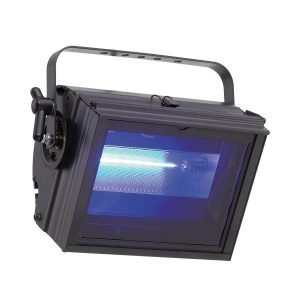
The Cyc or Cyclorama light has an asymetrical reflector that reflects most of the light downwards, so that when it is mounted at the top of the cyclorama, the intensity of the light is even from top to bottom of the cyclorama. acclaim-cyc_data
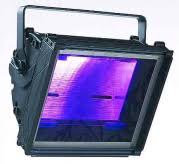
Fresnels and Pebble Convex Lights
The lens of the fresnel was invented for use in lighthouses to provide an soft edged beam, which makes it suited for most acting areas, as there is no noticeable change in intensity when an actor moves around the stage in a correctly focused lighting rig. The beam size is adjustable, usually from about 10 degrees to about 60 degrees.
The fresnel lens is stepped on the outside and lightly pebbled on the inside.
Because a fresnel lens produces some light scatter, they are usually fitted with barndoors.
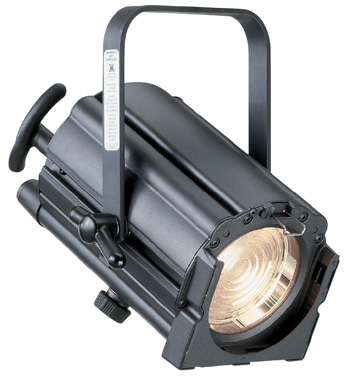
Fresnel
- acclaim_fresnel_Data_Sheet Acclaim Fresnel Data Sheet
The Pebble Convex light has lots of small dimples on the outside of the lens that produce a semi hard edge beam with less scatter than a fresnel. These were popular for sidelighting as they are a cross between a fresnel and a profile. Acclaim_Fresnel and PC Operation and Data sheet
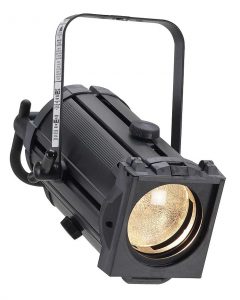
Profile Spots
These produce a hard edged beam that can be easily shaped to restrict the light beam to a specific area such as the proscenium arch of a stage, or a doorway or a window.
Why Use Profiles For Downstage Lighting
Natural light has an even intensity with no hot spots or dark patches when measured with a light meter in an open area with no shadows.
To achieve the same even intensity across the width of the stage requires the use of a light source that interacts with adjacent lights to achieve this even intensity.
A good quality Zoom Profile such as a Selecon Acclaim zoom profile has a lamp adjustment to provide PEAK or FLAT intensity of the light beam.
The PEAK intensity is used for acting area lighting so the intensity of the light is 50% at the sides of the beam, so where adjacent profile beams overlap, the sum of the two light beams is 100% to give an even intensity across the stage,to achieve natural lighting
The FLAT adjustment is for use with gobos for an even intensity across the light beam for realism of the projected shape to achieve natural lighting.
Using a Zoom Profile allows for different beam widths required for different angles of the outside rigging positions, where the optimal 45 degrees of the McCandless Method cannot be obtained. The shutters of the Zoom Profile are used to shape the beam for no spill outside the proscenium arch
This example from Light Shining In Buckinghamshire show the minister isolated in Middle Stage Centre using shutters in a profile spot and two Chancery church window gobos to place the actors in a church.
In a Profile Spot the plano convex lens can be moved to focus the beam. A common example in local theatres was the Strand Prelude 30 500/650W Profile. prelude30datasheet
A later development is the Zoom Profile that has two lenses to allow the beam angle or size to be varied as well as the focus.
Profiles usually have shutters fitted to allow the beam shape to be varied, such as changing it to a rectangular shape to light a doorway. The Selecon Acclaim Zoom Profile is available as 650W GY9.5 base version or the more efficient Axial Acclaim Zoom Profile that is as bright as most conventional 1000W profiles.
acclaim_axial_zoomspot_MKII Data sheet
A gobo can be fitted into a profile gate to allow for projection of a shape, such as a window or a leaf breakup.
The size of a profile beam can be adjusted by fitting an iris into the profile in the gate.
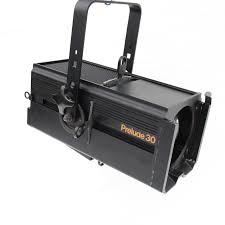
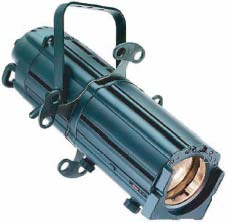
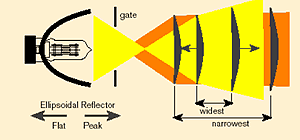
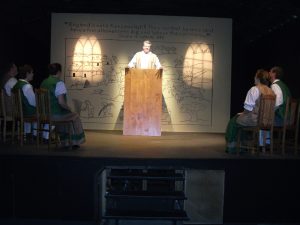
PAR’s or Parabolic Aluminised Reflector was the workhorse of the rock and roll industry lighting because of the bright light source that allowed for strong saturated colours,
PAR 16 Birdie has a seal beam lamp 16 x 16″ or 2 inch diameter. it is available in short nose or stubby and long nose. Short nose is useful as foot lights and for concealing lighting in a set. Long nose is useful as small specials. The sealed beam lamps are usually 12V as the 240V version is succeptable to filament damage when used as a foot light. Beam sizes for 12V are 10, 16, 24, 38, 50, 60 degrees.
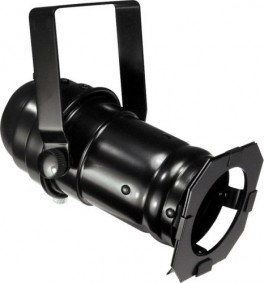
PAR 36 Pin Spot has a sealed beam lamp 2 1/4 ” diameter and a narrow beam angle of 5 degrees which makes it ideal for lighting mirror balls and wedding table centre pieces.
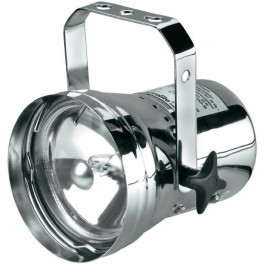
PAR 56 has a sealed beam lamp of 3 1/2″. It has an oval beam shape and is available in three beam angles, Wide Flood which has a lenticular lens with more rows or shorter rectangles, beam angle of 18 x 37 degrees, Medium Flood which has a lenticular lens which are rows of long rectangles, beam angle of 11 x 23 degrees, Narrow Spot which is textured fuzzy finish, beam angle of 8 x 10 degrees.
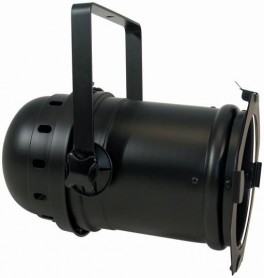
PAR 64 has a sealed beam lamp of 8″. It has an oval beam shape and is available in four beam angles, FFS or Wide Flood which has a lenticular lens with more rows or shorter rectangles, beam angle of 24 x 48 degrees, CP62 (FFR) or Medium Flood which has a lenticular lens which are rows of long rectangles, beam angle of 11 x 24 degrees, CP61 (FFP) or Narrow Spot which is textured fuzzy finish, beam angle of 11 x 14 degrees, CP60 (FFN) or Very Narrow Spot has a clear lens, beam angle of 9 x 12 degrees.
Needs checking.
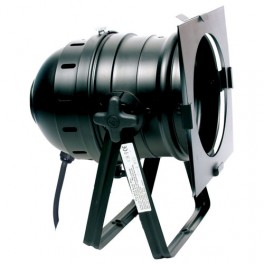
Source 4 PAR does not have a sealed beam lamp, they use a 575W HPL lamp which is comparable to a 1000W PAR lamp. The have four interchangeable lenses: VNSP, NSP, MFL, WFL.
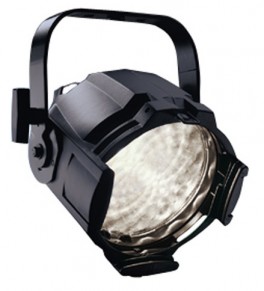
Light Meters
You do not need an expensive light or Lux meter to check the light beam of theatre lights. You can buy new ones from $50 or use an app on your smart phone.
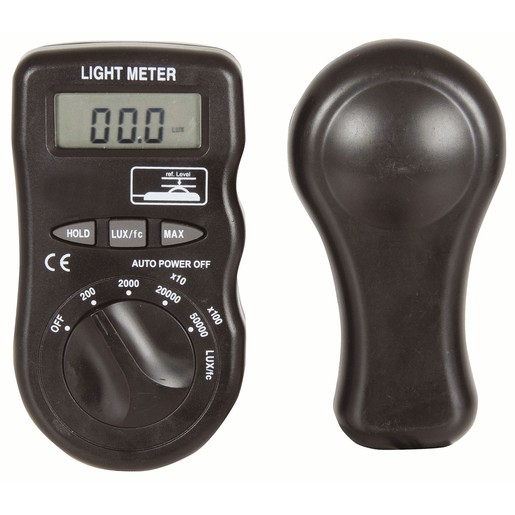
Page updated 25 March 2023